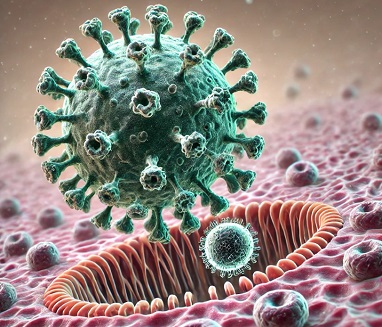Nikhil Prasad Fact checked by:Thailand Medical News Team Jun 28, 2024 9 months, 4 weeks, 19 hours, 4 minutes ago
COVID-19 News: In the fight against COVID-19, scientists are constantly discovering new ways the virus manages to invade our bodies. One of the latest findings is about a protein in our cells called SLC38A9. This protein plays a crucial role in how the COVID-19 virus, SARS-CoV-2, gets into our cells. This
COVID-19 News report covesr a recent study by researchers from the University of North Dakota School of Medicine and Health Sciences-USA that delved into the role of SLC38A9 in COVID-19.
 How Our Cells Help COVID-19 Invade: A Closer Look at SLC38A9
The Gatekeeper Protein: SLC38A9
How Our Cells Help COVID-19 Invade: A Closer Look at SLC38A9
The Gatekeeper Protein: SLC38A9
Solute carrier family 38 member 9 (SLC38A9) is a protein that in humans is encoded by the SLC38A9 gene. It is found inside our cells, specifically in a part called the endolysosome. Endolysosomes are like recycling centers where cells break down waste materials. SLC38A9 is a physical and functional component of the amino acid sensing machinery that controls the activation of a key cellular pathway called mTOR. This pathway is crucial for cell growth and metabolism.
How SARS-CoV-2 Enters Cells
The COVID-19 virus has a spike protein on its surface. This spike protein is crucial for the virus to attach to and enter our cells. The spike protein has two parts: S1 and S2. When the virus approaches a cell, enzymes in our body cut the spike protein, exposing a part that allows the virus to fuse with the cell membrane and enter the cell.
Importance of the Multibasic Motif
A key feature of the spike protein is the multibasic motif, a small segment with multiple arginine molecules. This motif is unique to SARS-CoV-2 and makes it more infectious compared to other coronaviruses like SARS-CoV-1. This motif allows the virus to interact with various cellular components more effectively, facilitating its entry and subsequent infection.
The Connection Between SLC38A9 and SARS-CoV-2
Scientists found that the multibasic motif of the SARS-CoV-2 spike protein interacts with SLC38A9. This interaction happens inside the endolysosome after the virus enters the cell. When the spike protein binds to SLC38A9, it causes the endolysosome to lose its acidic environment. This loss of acidity helps the virus avoid being broken down and allows it to release its genetic material into the cell, starting the infection process.
Why is this Interaction Important?
Research showed that when the SLC38A9 protein is not present, the spike protein cannot cause the endolysosome to lose its acidity. As a result, the virus has a harder time entering the cell and starting the infection. This means that SLC38A9 plays a critical role in the virus's ability to invade our cells. By understanding this interaction, scientists can look for ways to block it, potentially stopping the virus in its tracks.
Potential Treatments
Understanding this interaction opens up new avenues for treatment. If we can find a way to b
lock the interaction between the spike protein and SLC38A9, we might be able to prevent the virus from entering cells. This could lead to the development of new drugs that specifically target this mechanism. Such treatments would be particularly valuable in managing not only initial infections but also preventing severe disease and complications associated with long COVID.
Long COVID and Viral Persistence
This discovery also sheds light on why some people experience long COVID. Persistent viral proteins could interact with SLC38A9, causing ongoing disruptions in cell function. Long COVID is characterized by symptoms that last for weeks or months after the initial infection has cleared. These symptoms can include fatigue, brain fog, and respiratory problems. By targeting the interaction between SLC38A9 and the spike protein, we might be able to alleviate these long-term symptoms.
Research and Development
Further research is needed to fully understand the role of SLC38A9 in long COVID. However, this discovery provides a promising target for new treatments aimed at reducing the long-term impact of COVID-19. Scientists are already looking into how existing drugs might influence this interaction and whether new drugs can be developed to specifically target SLC38A9.
Conclusion
The discovery of the role of SLC38A9 in SARS-CoV-2 infection is a significant step forward in our understanding of how COVID-19 invades our cells. By targeting this interaction, we might develop new treatments to prevent or reduce the severity of COVID-19 infections. This research not only helps us fight the current pandemic but also prepares us for future viral threats. As we continue to uncover the intricate details of viral infections, we move closer to better health outcomes for everyone. This breakthrough highlights the importance of cellular proteins in the life cycle of viruses and opens new doors for therapeutic interventions.
Understanding how viruses interact with cellular machinery like SLC38A9 is crucial in our ongoing battle against infectious diseases. With continued research and innovation, we can hope to outsmart these pathogens and protect public health more effectively.
The study findings were published in the peer reviewed journal: iScience.
https://www.sciencedirect.com/science/article/pii/S2589004224016122
For the latest
COVID-19 News, keep on logging to Thailand Medical News.
Read Also:
https://www.thailandmedical.news/news/breaking-german-study-finds-that-sars-cov-2-is-using-endosomes-for-viral-entry
https://www.thailandmedical.news/news/study-finds-that-both-bacterial-cytolethal-distending-toxin-and-sars-cov-2-uses-cellugyrin-synaptogyrin-2-dependent-pathways-to-gain-cell-entry
